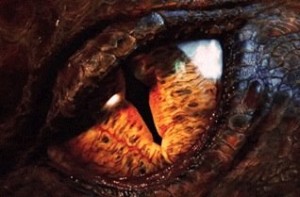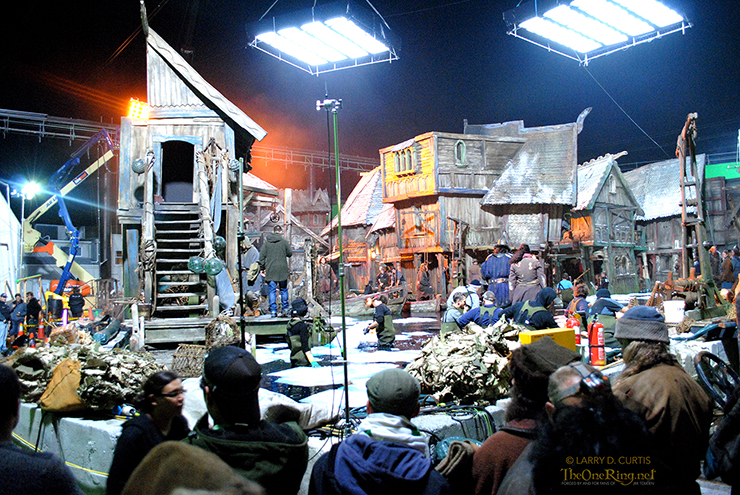
WELLINGTON — The great cities of history have risen up around rivers, lakes and on coasts. Water holds vast and replenishing stores of food, improves transportation of people and goods, encourages trade, and of course keeps a population hydrated. Paris. London. Hong Kong. New York. Tokyo. Moscow. Boston. On and on.
Lake-town benefitted from excellent transportation and presumably a wealth of fish and food and clean, fresh water but it was built on water for a different reason.
One dragon in particular: Smaug The Terrible.
Tolkien’s Lake-town, like real-world Venice, was built on wooden pillars sunk into water. The lake men — with the destruction of Dale seared forever into their memory — built on water for safety. We watched it in the prolog of “The Hobbit: An Unexpected Journey,” while they had to live with the fear of dragon every day. Water-based living provided at least a chance against the great and terrible worm if he ever attacked again.
Survival was the challenge for the city builders in Middle-earth but for Peter Jackson’s film version of Lake-town, dragon-sized demands included creating visuals to sell a water-based town to the audience and to provide a playground to let actors fully realize characters and moments.
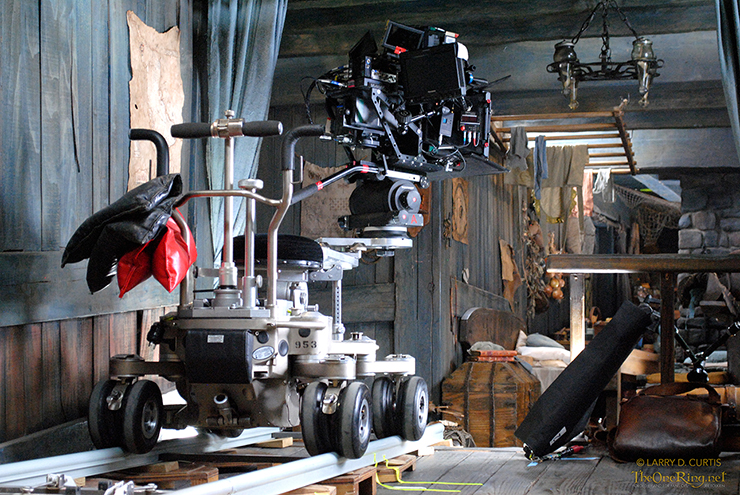
Vincent is an artist at heart, a sculptor and painter. He helped Jackson’s team on “King Kong,” as sculpting supervisor. During our visit he is relaxed and easy going, even on a large scale project with daily deadlines like “The Hobbit,” with his dark hair, his eyes playful, his smile easy to invoke. Not far from the sound stages, Vincent has a desk in an open, creative office with other key figures in the Art Department. Scattered around the office are concept pieces for sets including some watercolors from Vincent’s hand. He enjoys talking about the team.
From the corner of his desk, just down a hallway, sits a room sits that would simply blow the minds of fans of cinema and fans of Middle-earth alike. It serves as a visual showcase for sets from the film.
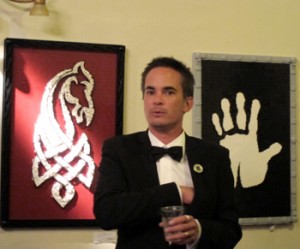
In one section sits a wooden, rustic desk with pinecones and some of the more mundane items one might find in the dwelling of an eclectic wizard. Above it hangs concept art and colors.
But the room, which would impress any visitor from any studio or the public or anywhere, isn’t made to show off at all.
“No, no this is very practical. We generate all these color swatches for fabric and that way we can really control the color quite accurately on the set so you can finish a set with interesting things. To give visual strength to certain areas, you can tie a room together with color.
“This is Radagast — from his house — and then by making a little installation like this, these guys (staff from the art department) can come and they know that there is a certain kind of color that we’re working toward and they can reference this. These are sort of practice pieces if you like, and development with the rest of the environment.”
Several specific regions of Middle-earth were represented. The natural but vibrant colors of Hobbiton moving around the room to Thranduil’s elven realm.
“It’s all that blue and silver and gold, so everything kind of became kind of glassy and quiet and still with blue but we gave a warm and inviting feeling with the introduction of gold and silver metallics and pivotal to the elven aesthetic is the layer of shimmer on everything. It gives it a magical otherworldly sort of sensation.”
The goblins realm is next, the results on screen in the first film.
“These guys, being subterranean kind of critters that live in a hive environment, also have their individual curiosities. All we did with goblin world was to put a whole lot of different set dressers in there who all had their own kind of quirky aesthetic that they are working on and by doing that we can individualize the spaces.
“(We) have a goblin sitting at a kind of child’s rocking chairs next to a portrait of something completely off the wall like a cow’s head. It’s quite lovely for the set dressers because they get this sort of diverse opportunity.”
Next is Radagast’s section, now, like the goblin caves, familiar to moviegoers.
“We generate a quite a bit of the dressing for these environments so not only are the swing operators responsible for putting in and taking away objects for finishing, but they also manufacture all this stuff.”
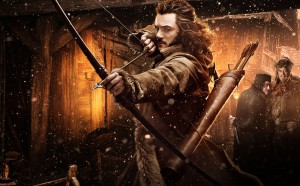
“He (Radagast) has a very eclectic style and in order to get going, we brought in a weaver who sat down with the truck driver, the coordinator, the swing gang, some movers, the store-men and they all learned how to weave baskets in one day. Then they carried on weaving these baskets for another five days, so we ended up with the most extravagant individualized pieces. We did the same thing with a book binder. Now we have a team of very good weavers and book binders who generally in their normal day-to-day jobs would be truck drivers or coordinators.”
The room continues on to Radagast’s naughty neighbors.
“Then the spider forest was exciting and Mirkwood — wonderful set to work in. We gave it a poisonous quality that hopefully you’ll see on screen. It was all painted very vivid color-wise. I think in that way Peter can control the progression through the forest through his color grading later on and start off with a fairly conventional kind of spooky looking forest and then you (lead) up to the most outrageous spider-infested home.
“And without being wasteful we do make sure that we’re covered. It’s always good to give the director as many options as we can.”
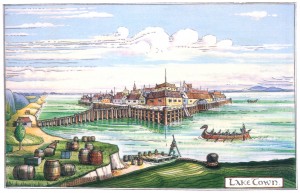
“The original inspiration was slightly different from what we ended up with. This is interesting, the translation. Take kind of simplistic drawings but I think they are simple enough that you hand the drawing over, a prop designer will pull that out and draw it up and it’s typical of that process.”
Lake-town isn’t just one set during the shoot, its several. Some exteriors scenes shot on a wet indoor soundstage. The Bowman residence interior was on another stage, replicated in two scales. Giant walnuts, tiny walnuts. Absurdly big model boat, petite model boat. Fans know the drill from the LOTR movies but it is no less miraculous to see the attention to detail. Corn kernels come in two sizes.
In a five-week embed, various versions of Lake-town go up and down, sometimes very literally overnight. So while no single place or set is Lake-town, in the middle of the outdoor lot of Jackson’s Stone Street Studios, an enormous practical Lake-town dominates the grounds. Its a wet set, meaning everything is on, in or surrounded by a shallow man-made lake, kept behind cement barriers. On one side looms a permanent jumbo green screen wall big enough to keep King Kong out. Enormous cranes are rigged with overhead lights and the illusion of a village on a lake is pretty emotionally convincing. You can tell the difference of course but to find an angle that looks 100% convincing isn’t difficult at all. Emotionally, it feels like the real thing.
Out of the magical art room and building, Vincent is equally at home giving a tour of this two story practical set. Its one of those moments when I could hardly believe I am there, walking up and down stairs, across bridges and seeing the set dressing highlights with Ra, an enthusiastic gentleman-artist that is difficult not to really like.
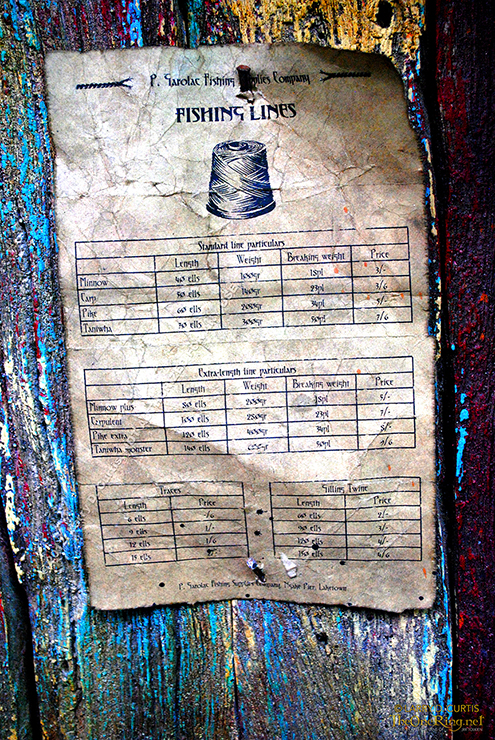
In another section rests a magnificent oversized leather book. While nearly every object is made, including books and paperwork, Vincent remembers that this one isn’t.
“I purchased that from a bank that was closing down in Wellington that was clearing out their basement and they had these 150-year-old ledgers. It is incredible.”
At another corner we find a wonderfully decorated niche that I suspect from my time as an extra the previous week will make at least a background appearance in the film and sharp audience eyes will be rewarded.
“In the prep or the initial dress (of the set) the idea is to tell little stories. I don’t think anyone has played with this too much. This is just a little room where there are a little bit of Lake-town remedies going on here where you come to buy your secret herbs for various ailments.
“Our set dressers conceived of the oddball pagan bits and pieces to set up a magic potion shop. This is very off-the-wall stuff and it’s only ever meant to be background, even just having a little hint of it is kind of fun because its so well laid out and everything has been thought about and positioned nicely.”
Around a corner is a copper bath and a boiling water heater to keep the imaginary townies, clean, at least sometimes. It is beautiful in fact. Nobody will ever take a bath there, but it would be difficult to argue that it isn’t art. What if it never gets on screen? What if nobody ever sees it?
“We kind of decided at the beginning of the job that we were going to make museum-quality pieces because there is no point in making rubbish if all you’re going to have to do is remake it over and over again. So we set up a bronze foundry and we brought beautiful timber for making the best quality pipes. There is nothing quite like holding a knife that is made out of the real thing rather than a rubber version or a plastic version or something, it kind of needs . . . it should have the weight and should behave the way the object is supposed to behave.”
I wish it could all go to a museum, mindful of friends and TORn users that would cherish the chance to see this first hand. Mindful of the need for a film to tell a great story, I am also aware that it all simply cannot all be captured by the cinematic camera.
“Even at the end of the day if it doesn’t end up on screen, one of the actors had the enjoyment of getting into character because he was sitting at the table and there was all those little details in front of him. I think I’ve achieved my job. A lot of this stuff audiences will never see but I think it’s great. Everybody onset and offset that made it, knew that it was there and we know how rich the film is and hopefully even if it’s not literally seen on screen it will be felt.”
Vincent gives me run of the set and I use it to photograph as many of the details as possible without being an absurd guest. There are plenty of visual clues about who lives where and does what. A fishmonger lives in the main plaza. There are hunters who successfully hunted flying foul (manufactured props) and the city of Lake-town either imports or grows a variety of vegetables. The citizens enjoy eels. There is plenty of paperwork involving trade and with the Master of Lake-town’s stamp as well as information about the city’s imports and exports. A few weapons rust in storerooms. Beyond the set dressing, the set itself is intricate and amazing. Broken statues, weathered boats, moss growing on stones, wooden supports done with a fish motif and water gates all impress, all of it set on a man-made, illusion-giving “lake.”
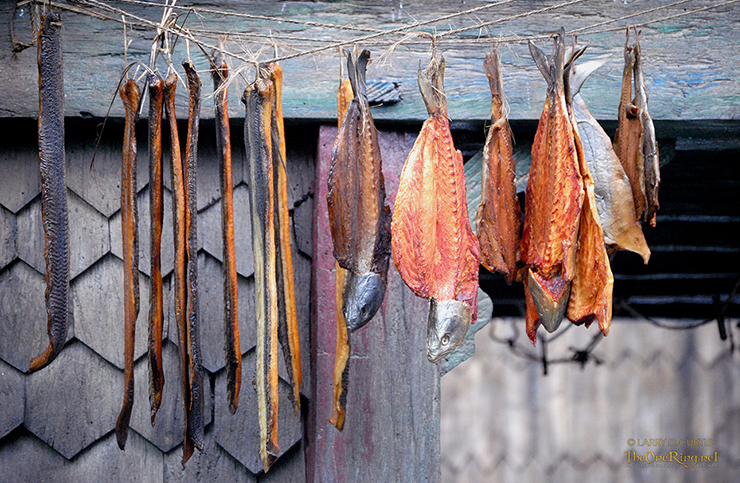
The next day the tour continues, but now via car on the way from Stone Street to see where all this Lake-town and other set dressing comes from. Not far from the studio we enter a production workshop in full on work mode. It is noisy, filled with various scents of materials and labor, including woodwork.
Weta Workshop designs and builds weapons and armor for actors and extras but the art department must populate the background with identical items modeled after Weta’s stuff. The day we visited, the first of about 500 spears were in production progress along with thousands of arrows.
Another artist was busy making pottery.
“Every pierce of ceramic that appears in “The Hobbit,” has come through this kiln,” Vincent said. “He has probably touched every single one of them. At the moment he is working on some jugs, probably for cognac.”
We see a saddle-making and leather station. We see the bronze foundry.
“It is easier to make the real thing than make plastic moulding,” he explained.
There is plenty of wood-working going on.
“Sometimes we mill our own timber to get the sizes right.”
There is a jeweler working on a piece of significant and beautiful jewelry that may show up in the prolog of the second film and has something to do with Thranduil. Special cuts of stone were imported and because the craftswoman working on it is something of a specialist, much of it will be finished with silver.
“It is easier for her to make it for real than to fake it. All except the diamonds of course!”
The amazing goes on and on, but Vincent has more to show. Another short car ride and we are at the warehouse where snow banks and floating ice chunks are manufactured. From there it is on to storage.
And storage is yet another prime geek dream destination inside the warehouses that serve to keep film artifacts safe. Cataloged and shelved, it and others like it, hold the treasures of Middle-earth. Its riches are laughable and even the mundane becomes pop-culture art.
All I can think about is a Middle-earth, movie-prop museum. Oh to play a part in presenting such a place to fans! It would be like watching kids faces at Disneyland but the faces would belong to adults, some of whom would gasp in wonder or come close to tears — reactions the Hobbiton Movie Set evokes in Matamata currently.
Vincent has done an exceptional job with show and tell. (In fact there was much more of both than can possibly be crammed into this report and we haven’t even started with time spent with Mr. Hennah at all!)
Back to the “A” soundstage, with Bard’s house in both scales. Naturally this potential hero can’t live in a vacuum but rather in an organic community. He chooses what to wear every morning from clothes that must have been made by someone and must have a place to hang. He likely washes them as well. He must make a living, have skills or hobbies, possibly friends or enemies and now its been revealed — a family. (Might even need a place to store some old arrows or something.) A year after the initial visit, during a shorter and more secretive drop-in, old Lake-town was still in play.
There was always talk about the set about the rather amazing quarters of the Master of Lake-town that I never witnessed. And I haven’t even mentioned (until now) a whole different set for the city’s armory, with its age and symmetry and lovely colors. It was exceptionally fun to photograph.
Yes readers (and if you made it this far, accept my virtual pat on the back) Lake-town was, and will be, astonishing art that you will be too busy to notice on your first screening but will be worth your time to scrutinize on subsequent viewings. A quick aerial shot in one of the trailers shows a nighttime realization on a screen of the artistry by a team of creators, all serving Jackson’s vision. And Weta Digital, hardly mentioned here, will be the last to touch the city before it is handed off for screenings.
The finished place might even turn out to be one of the great cities in cinematic history — built near water of course, for dragon’s sake, and Pete’s.
Larry D. Curtis is part of the Senior Staff at the all-volunteer TheOneRing.net where he serves as a writer, editor, photographer, consultant and helps with social media and live events. His TORn pen name is MrCere. He is a freelance writer and creative, always looking for new endeavors. He is a filmmaker, a student and a fan of fans.
Email: Email Me
Twitter: @MrLDC
See also: Set visit exclusive — Extras: Living large in the background of ‘The Hobbit’
Note: Special thanks to @Saoirse_Lochlan from Twitter who helped transcribe for this report.


